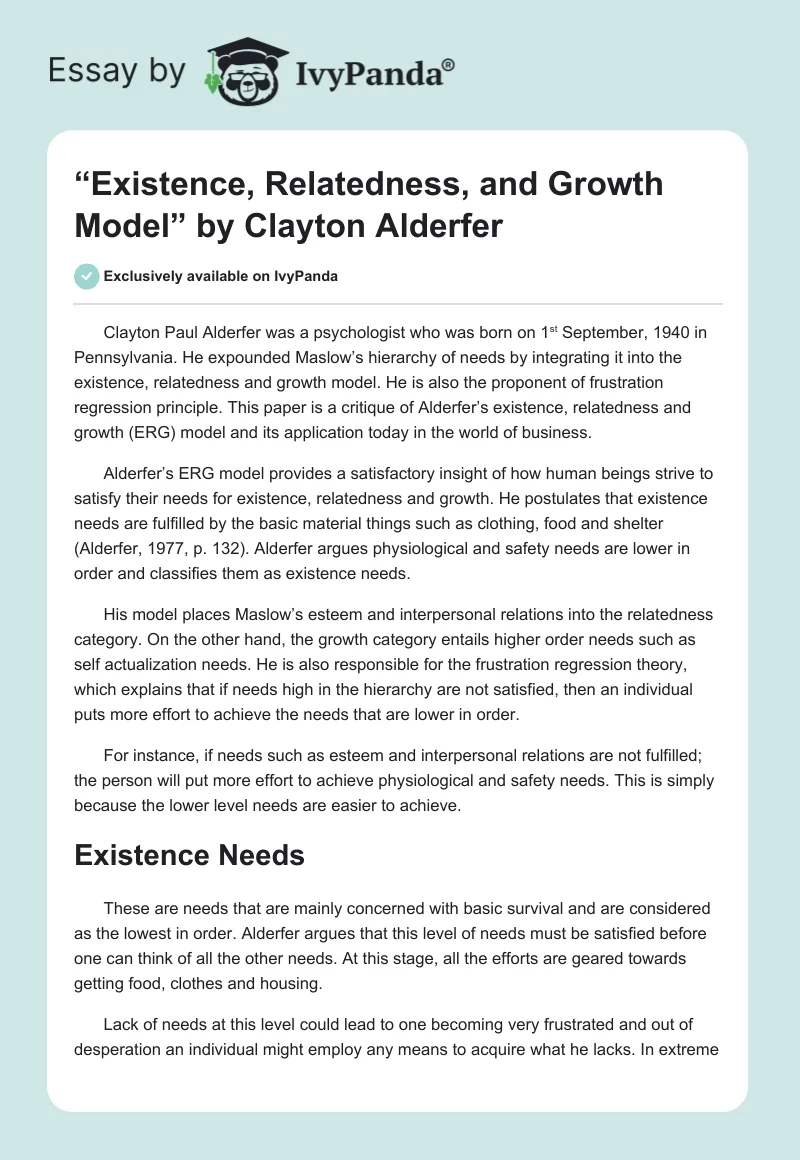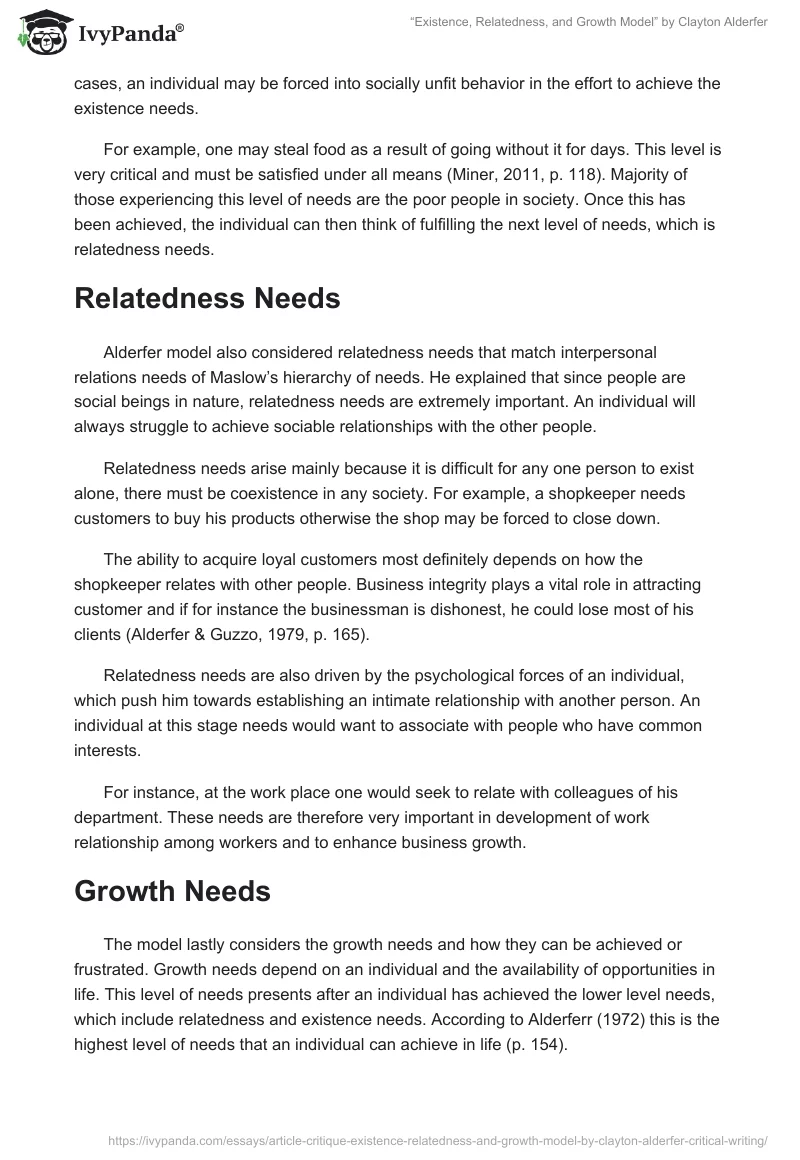Clayton Paul Alderfer was a psychologist who was born on 1st September, 1940 in Pennsylvania. He expounded Maslow’s hierarchy of needs by integrating it into the existence, relatedness and growth model. He is also the proponent of frustration regression principle. This paper is a critique of Alderfer’s existence, relatedness and growth (ERG) model and its application today in the world of business.
Alderfer’s ERG model provides a satisfactory insight of how human beings strive to satisfy their needs for existence, relatedness and growth. He postulates that existence needs are fulfilled by the basic material things such as clothing, food and shelter (Alderfer, 1977, p. 132). Alderfer argues physiological and safety needs are lower in order and classifies them as existence needs.
His model places Maslow’s esteem and interpersonal relations into the relatedness category. On the other hand, the growth category entails higher order needs such as self actualization needs. He is also responsible for the frustration regression theory, which explains that if needs high in the hierarchy are not satisfied, then an individual puts more effort to achieve the needs that are lower in order.
For instance, if needs such as esteem and interpersonal relations are not fulfilled; the person will put more effort to achieve physiological and safety needs. This is simply because the lower level needs are easier to achieve.
Existence Needs
These are needs that are mainly concerned with basic survival and are considered as the lowest in order. Alderfer argues that this level of needs must be satisfied before one can think of all the other needs. At this stage, all the efforts are geared towards getting food, clothes and housing.
Lack of needs at this level could lead to one becoming very frustrated and out of desperation an individual might employ any means to acquire what he lacks. In extreme cases, an individual may be forced into socially unfit behavior in the effort to achieve the existence needs.
For example, one may steal food as a result of going without it for days. This level is very critical and must be satisfied under all means (Miner, 2011, p. 118). Majority of those experiencing this level of needs are the poor people in society. Once this has been achieved, the individual can then think of fulfilling the next level of needs, which is relatedness needs.
Relatedness Needs
Alderfer model also considered relatedness needs that match interpersonal relations needs of Maslow’s hierarchy of needs. He explained that since people are social beings in nature, relatedness needs are extremely important. An individual will always struggle to achieve sociable relationships with the other people.
Relatedness needs arise mainly because it is difficult for any one person to exist alone, there must be coexistence in any society. For example, a shopkeeper needs customers to buy his products otherwise the shop may be forced to close down.
The ability to acquire loyal customers most definitely depends on how the shopkeeper relates with other people. Business integrity plays a vital role in attracting customer and if for instance the businessman is dishonest, he could lose most of his clients (Alderfer & Guzzo, 1979, p. 165).
Relatedness needs are also driven by the psychological forces of an individual, which push him towards establishing an intimate relationship with another person. An individual at this stage needs would want to associate with people who have common interests.
For instance, at the work place one would seek to relate with colleagues of his department. These needs are therefore very important in development of work relationship among workers and to enhance business growth.
Growth Needs
The model lastly considers the growth needs and how they can be achieved or frustrated. Growth needs depend on an individual and the availability of opportunities in life. This level of needs presents after an individual has achieved the lower level needs, which include relatedness and existence needs. According to Alderferr (1972) this is the highest level of needs that an individual can achieve in life (p. 154).
At this level, the individual is characterized by power, wealth and riches, fame and self esteem. One feels that he has achieved everything and this feeling is termed as self actualization. However, this stage is achieved through hard work and sometimes one may be required to sacrifice a lot. The stage harbors the elite in the society, who include people like politicians and business tycoons (Natemayer & Hersey, 2011, p. 189).
Application of Existence, Relatedness and Growth Model in Today’s World of Business
Alderfer explains that as one move up the ladder, the more difficult it becomes to achieve needs at that level. For example, the complexity of satisfying relatedness needs at the work place is intensified by differences of individual needs. This is because people working together at any institution, are at different stages of fulfillment or regression.
Some may be aiming at the big shot while others may be striving to achieve existence needs. It is therefore very important for managers to address the three needs so as to alleviate any impending conflict among workers. Some workers may be more inclined to growth needs than existence or relatedness needs; providing a platform for their growth is therefore very necessary to avert depression.
Alderfer’s theory explains that everybody has all the three needs, although at different levels and modes. This makes the concern of fulfilling them quite complex and depends on an individual. Some people can do anything and may go a long way to achieve their growth needs.
Growth needs can motivate an individual to work very hard in order to outshine others and to acquire recognition aimed at gaining promotion at work. However, if the efforts go unnoticed, the worker may become very frustrated and the consequences are likely to be seen in terms of reduced work input.
If not satisfied, relatedness needs cam cause a lack of team spirit in the work place (Natemayer & Hersey, 2011, p. 109). For example, an individual who is working very hard to develop his place of work may be spited by her colleagues’ interest in their status quo and this could develop hatred or impact negatively on the business.
In some cases, all the workers may be willing to work as a team to boost the productivity of the business. However, their individual needs should not be taken for granted. The manager should look for ways to motivate the workers to persist in working hard.
Factors such as job satisfaction, safe working environment, job security and availability of promotion opportunities are great incentives to workers (Natemayer & Hersey, 2011, p. 189). For the business to experience fewer conflicts, individual needs of all the workers must be satisfied. For example, a worker who has money problems at home will tend to be inclined towards the level of pay.
Failure to harmonize the pay of workers with the current economic standards may motivate them to go on strike over pay increment. On the other hand, a worker who works very hard to get a promotion and he does not get one may become redundant.
Therefore, the business should have a well laid blueprint of how their needs will be fulfilled. In conclusion, Alderfer’s model is vital in the working environment. His main concern is whether needs are satisfied or not, and he explains that these two options determines whether the individual becomes fulfilled or frustrated.
References
Alderfer, C. P. (1972). Existence, Relatedness, and Growth: Human needs in organizational settings. New York, NY: Free Press.
Alderfer, C. P. (1977). A critique of Salancik and Pfeffer’s examination of need- satisfaction theories. Administrative Science Quarterly, 22(4), 658-669.
Alderfer, C. P., & Guzzo, R. A. (1979). Life experiences and adults’ enduring strength of desires in organizations. Administrative Science Quarterly, 24(3), 347-36.
Miner, J. B. (2011). Organizational Behavior 6: Integrated theory development and the role of the unconscious. New York, NY: Sharpe Inc.
Natemayer, W. E., & Hersey, P. (2011).Classics of organizational behavior (4th ed.). Illinois, IL: Waveland Press.


